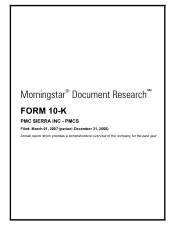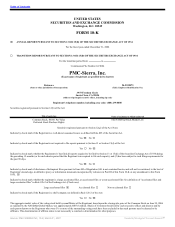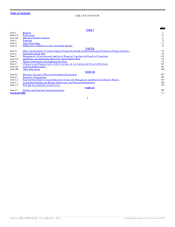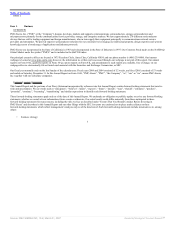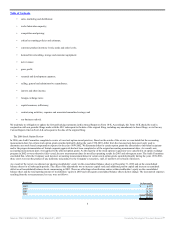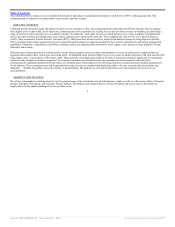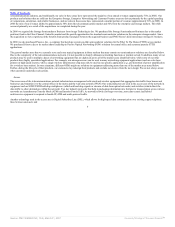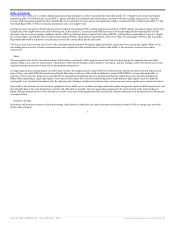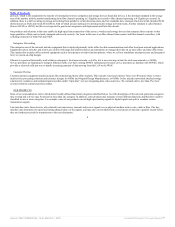Adaptec 2006 Annual Report Download - page 11
Download and view the complete annual report
Please find page 11 of the 2006 Adaptec annual report below. You can navigate through the pages in the report by either clicking on the pages listed below, or by using the keyword search tool below to find specific information within the annual report.
Table of Contents
Framers and mappers: before the data can be sent to the next destination, it must be converted into a proper format for transmission in the network. For example,
the framing function arranges the bits into different size formats, commonly referred to as “cell” or “packet” formats, and attaches the appropriate information to
the formats to ensure they reach their destinations. In turn, this data may be inserted into other frames, such as SONET/SDH frames, for transmission across
high-speed fiber optics.
Packet and cell processors: these devices examine the contents of cells, or packets, and perform various management and reporting functions. For instance, a
switch or router may use a packet or cell processor to determine if a signal is voice or video in order to allocate the proper amount of bandwidth.
Controllers: rapid growth in data storage needs is driving a requirement for more cost-effective and larger capacity storage systems. Controller products based on
Fibre Channel, Serial Attached SCSI (SAS), and Serial ATA (SATA), are enabling technologies for building network-attached storage system architectures that
meet the new cost and capacity needs.
Traffic managers and switch fabrics: traffic managers organize, schedule and queue cells and packets into and out of switches. Switch fabrics interconnect the
wires and fibers, allowing the data to be routed to its intended destination.
Microprocessors: these devices perform the high-speed computations that help identify and control the flow of signals and data in many different types of
network equipment used in the communications, enterprise and consumer markets. With greater demand for integration of features and functions on a single
device, more system-on-chip solutions are being developed.
Serializers/Deserializers: these devices convert networking traffic between slower speed parallel streams and higher speed serial streams. OEMs use serial
streams to reduce networking equipment line connections, and parallel streams to allow them to apply lower cost traffic management technologies.
System-On-A-Chip (SOC’s) : Integrated I/O’s, microprocessors, memory, system bus, and physical layer functions on one monolithic semiconductor device
(chip).
OUR STRATEGY
Our high-speed semiconductor solutions are based on our knowledge of network applications, system requirements and networking protocols, and high-speed
mixed-signal and system-on-chip design expertise. To achieve our goal of profitably expanding our business, we are pursuing the following five strategies:
1. Expand our breadth of product solutions in the enterprise storage systems market.
We are broadening our product line in the enterprise storage markets. In addition to our Fibre Channel product line, we have leading edge high-performance
interconnect devices designed
9
Source: PMC SIERRA INC, 10-K, March 01, 2007 Powered by Morningstar® Document Research℠

